#Japanese History in Seattle
Explore tagged Tumblr posts
Text
On June 12, 2001, Battle Royale was screened at the Seattle International Film Festival.

Here'ss a new drawing of Masanobu Ando as Kiriyama!
#battle royale#masanobu ando#j horror#horror movies#horror art#dystopian film#japanese film#dystopian science fiction#action thriller#splatter film#splatter movies#splatter#2000s horror#2000s movies#movie art#art#drawing#movie history#pop art#modern art#pop surrealism#cult movies#portrait#cult film#seattle international film festival
2 notes
·
View notes
Photo

The legacy of a Japanese American family's variety store When president Roosevelt signed executive order 9066, over 100,00 men, women and children of Japanese ancestry were interned in relocation centers, far from the West Coast. In most cases the farms, homes and businesses they were forced to leave were lost or taken over. — Read the rest https://boingboing.net/2023/03/21/the-legacy-of-a-japanese-american-familys-variety-store.html
0 notes
Text
a brief history of forced assimilation and language loss in japanese american (nikkei) comumunities
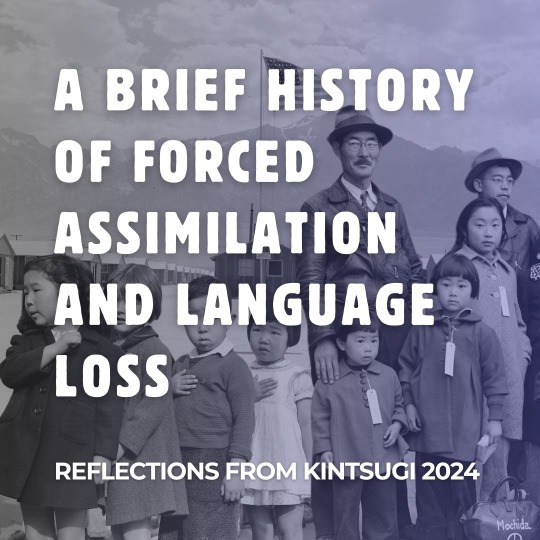
[image description: the words "a brief history of forced assimilation and language loss, reflections from kintsugi 2024" appear over a composited photo of a japanese american man with children all wearing their camp ID tags and children with their hands over their hearts as if reciting the pledge of allegiance. the background is the camp barracks with an american flag flying in front.)
kintsugi 2024 was a conference for nikkei folks to talk about generational trauma and repair. denshō, the organization that archives our history related to the ww2 incarceration, released this series of infographics on their instagram page (shared with permission).
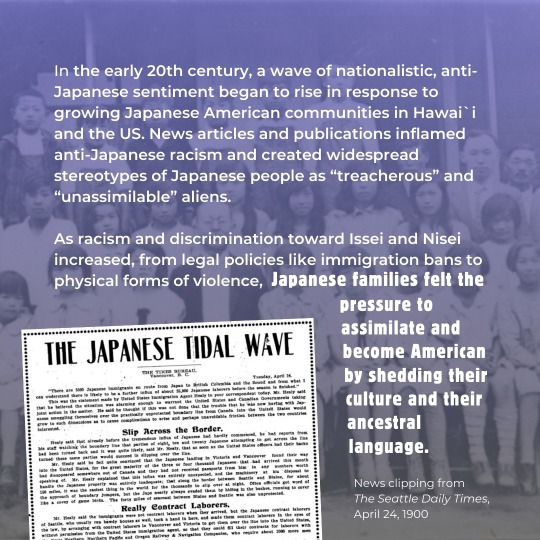
[image description: text reads, "in the early 20th century, a wave of nationalistic, anti-japanese sentiment began to rise in response to growing japanese american communities in hawai'i and the US. news articles and publications inflamed anti-japanese racism and created widespread stereotypes of japanese people as 'treacherous' and 'unassimilable' aliens.
as racism and discrimination toward issei and nisei increased, from legal policies like immigration bans to physical forms of violence, japanese families felt the pressure to assimilate and become american by shedding their culture and their ancestral language."
a news clipping from the seattle daily times april 24, 1900 is included with the headline "the japanese tidal wave." all text appears over a posed group photo of nikkei people from the turn of the 20th century. end ID]
"issei" means first generation, the original immigrants, and "nisei" is the second generation.
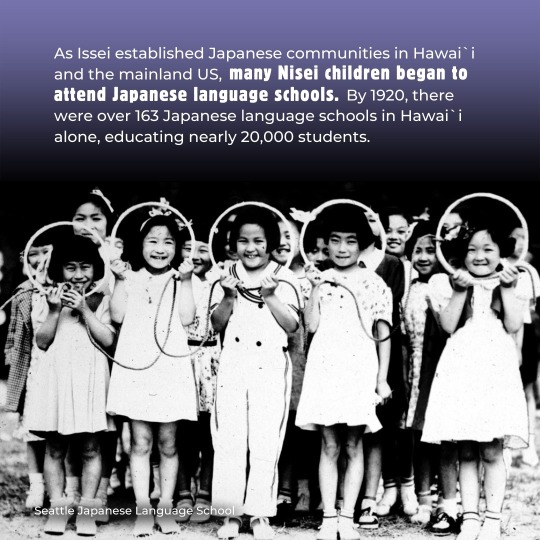
[image description: text reads, "as issei established japanese communities in hawai'i and the mainland US, many nisei children began to attend japanese language schools. by 1920, there over 163 japanese language schools in hawai'i alone, educating nearly 20,000 students."
the text is above a photo of an early 20th century class of the seattle japanese language school, elementary school-aged children smiling and holding up hoops and jump ropes. end ID]
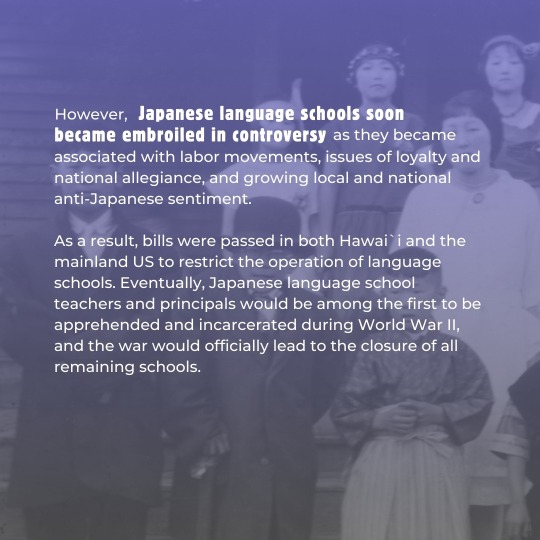
[image description: text reads, "however, japanese language schools soon became embroiled in controversy as they became associated with labor movements, issues of loyalty and national allegiance, and growing local and national anti-japanese sentiment.
as a result, bills were passed in both hawai'i and the mainland US to restrict the operation of language schools. eventually, japanese language school teachers and principals would be among the first to be apprehended and incarcerated during world war 2, and the war would officially lead to the closure of all remaining schools."
text is superimposed over a photo of japanese americans of various ages in 1920's western wear as well as traditional japanese garb. end ID]
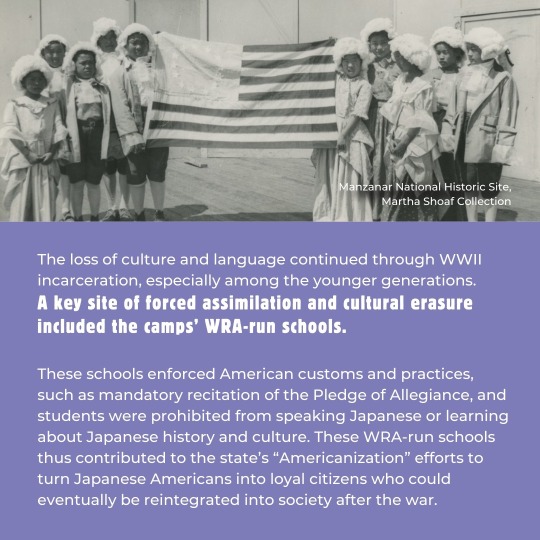
[image description: text reads, "the loss of culture and language continued through ww2 incarceration, especially among the younger generations. a key site of forced assimilation and cultural erasure included the camps' WRA-run schools.
these schools enforced american customs and practices, such as mandatory recitation of the pledge of allegiance, and students were prohibited from speaking japanese or learning about japanese history and culture. these WRA-run schools thus contributed to the state's 'americanization' efforts to turn japanese americans into loyal citizens who could eventually be reintegrated into society after the war."
the text appears below a photo depicting incarcerated nikkei children in 18th century colonial american costume holding up a recreation of the original 13-star betsy ross flag. end ID]
WRA is the acronym for the war relocation authority which oversaw the forced removal of nikkei people from so-called 'military exclusion zones,' aka anywhere within 300 miles of the western coast of the US.
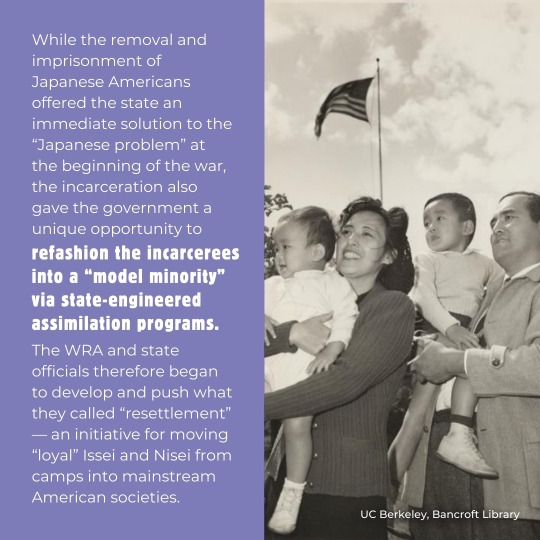
[image description: text reads, "while the removal and imprisonment of japanese americans offered the state an immediate solution the the 'japanese problem' at the beginning of the war, the incarceration gave the government a unique opportunity to refashion the incarcerees into a 'model minority' via state-engineered assimilation programs.
the WRA and state officials therefore began to develop and push what they called 'resettlement' - an initiative for moving 'loyal' issei and nisei from camps into mainstream american societies."
the text appears to the left of a photo of a four person family. the parents wear smiles and hold a toddler in each of their arms while an american flag flies above them in the background. end ID]
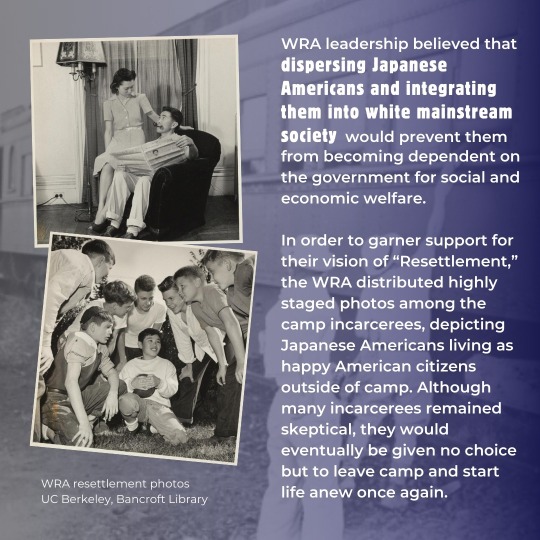
[image description: text reads, "WRA leadership believed that dispersing japanese americans and integrating them into white mainstream society would prevent them from becoming dependent on the government for social and economic welfare.
in order to garner support for their vision of 'resettlement,' the WRA distributed highly staged photos among the camp incarcerees, depicting japanese americans living as happy american citizens outside of camp. although many incarcerees remained skeptical, they would eventually be given no choice but to leave camp and start life anew once again."
the text is superimposed over a photo of two people in white garb shaking hands with someone through a train window. two WRA propoganda photos to the left of the text show a japanese american couple at home, the wife sitting on arm of the husband's easy chair while he reads a newspaper and smokes a pipe, and a japanese american child in the middle of a football huddle with eight other children, all of whom are white. end ID]
many nikkei families were terrified to leave camp following the war knowing that americans saw them as the enemy. the people who were lucky enough to return to the communities they had lived in before the evacuation found anti-japanese signs on their neighbors houses and vandalization of any property that remained to them. my great-grandfather's farmhouse was burned down, confirmed arson. i can't imagine going back there and wondering which of your neighbors did it.
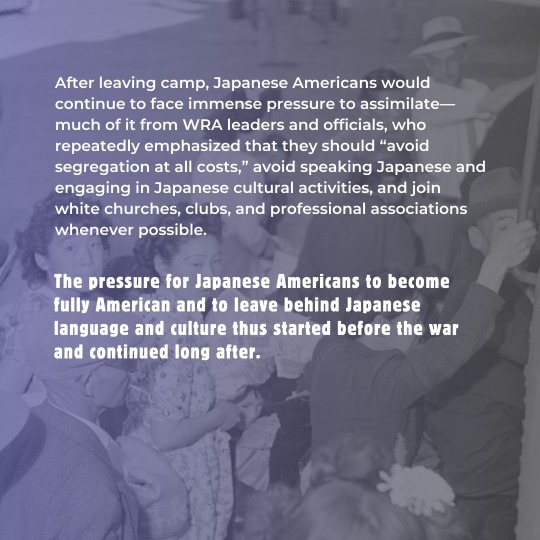
[image description: text reads, "after leaving camp, japanese americans would continue to face immense pressure to assimilate - much of it from WRA leaders and officials, who repeatedly emphasized that they should 'avoid segregation at all costs,' avoid speaking japanese and engaging in japanese cultural activities, and join white churches, clubs, and professional associations whenever possible.
the pressure for japanese americans to become fully american and to leave behind japanese language and culture thus started before the war and continued long after."
the text is superimposed over an image of nikkei people in 1940's western dress boarding a train. end ID]
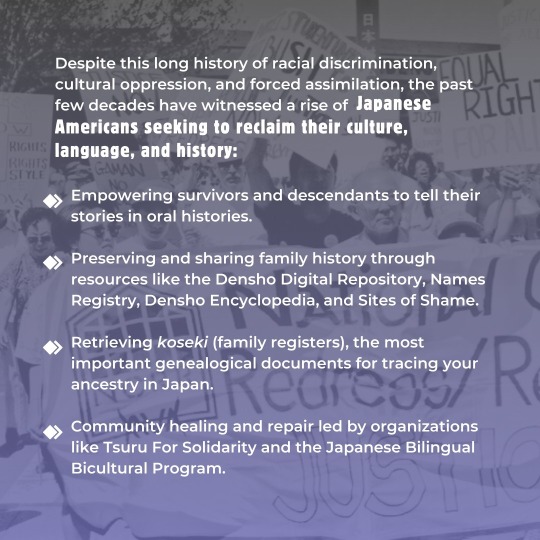
[image description: text reads, "despite this long hisory of racial discrimination, cultural oppression, and forced assimilation, the past few decades have witnessed a rise of japanese americans seeking to reclaim their culture, language, and history:
-empowering survivors and descendants to tell their stories in oral histories.
-preserving and sharing family history through resources like the denshō digital repository, names registry, denshō encyclopedia, and sites of shame.
-retrieving koseki (family registers), the most important genealogical documents for tracing your ancestry in japan
-community healing and repair led by organizations like tsuru for solidarity and the japanese bilingual bicultural program."
text is superimposed over an image of nikkei protestors in the 1980's campaigning for the redress movement, a national coalition of survivors and descendants of the incarceration camps. end ID]
these are some of the specifics related to nikkei assimilation, but it's important to note that this happens to varying degrees to all ethnicities under the american colonial project.
#actually nikkei#japanese american history#japanese american incarceration#assimilation and language loss#日系#日系人
3 notes
·
View notes
Text
[“In 1916, the City of Seattle embarked on a massive engineering project to link the city’s freshwater lakes with Puget Sound and create an industrial waterway for commercial traffic. The project lowered the water level of Lake Washington by several feet, which destroyed sluʔwiɬ, among other Indigenous sites, and further displaced the Duwamish from their homelands and waters.
The University of Washington took over the newly available slice of property and leased it to the city for use as a landfill beginning in the mid- 1920s. Nicknamed the Montlake Fill, the site frequently caught fire, spewed toxic fumes and dust, and attracted swarms of rats and flies. Around this time, two Japanese families arrived in the area and opened up produce farms just a short walking distance away from the Montlake Fill, on the precise location of what would become the University Village mall. Widespread anti-Japanese hostility, discriminatory laws, and prohibitions on property ownership had driven many Japanese from the farming business. But these families occupied what the city and real estate industry then considered worthless land, so they encountered little resistance as they built homes, raised children, and worked every day of the year to provide fresh vegetables to local markets around Seattle. Their hard-earned livelihoods quickly unraveled in the aftermath of Japan’s attack on Pearl Harbor and the entry of the United States into World War II. As renters, the families had little protection or recourse when President Roosevelt ordered that all persons of Japanese ancestry be removed and confined to inland concentration camps in 1942. What they couldn’t sell or store in the frantic days before their removal, the landlords confiscated for themselves.
After the war, investors began to eye this newly desirable land as an ideal location for a shopping mall. During the postwar period, the northern areas of Seattle had transformed from rural farmlands into a sprawling residential district for white families. The U Village company owners envisioned the mall as an explicitly suburban retail space and a gateway to the segregated, exclusionary neighborhoods of North Seattle. The mall’s construction went hand in hand with postwar white suburban development, raising property values and offering an insulated retail environment to match the area’s insulated racial environment. The longer history of the U Village mall thus reveals its creation not as an open, accessible retail space for down-on-their-luck Seattle families, but as an engine of segregation and white wealth accumulation built upon colonized lands and racialized displacement.”]
megan asaka, from seattle from the margins: exclusion, erasure, and the making of a pacific coast city, 2022
51 notes
·
View notes
Text
Local Author Event: Seattle Samurai

Kelly Goto's new book, Seattle Samurai: A Cartoonist's Perspective of the Japanese American Experience, is a commemoration of the life and work of not just her father, but also the early Japanese immigrants of Seattle and those who came after. This beautiful coffee table book celebrates the art and life of Kelly's father, Sam Goto, and features many strips from his 2012-2018 comic strip Seattle Tomodachi, alongside gorgeous photography. Sam was a longtime Seattle and Mercer Island resident and began Seattle Tomodachi at the encouragement of his wife, Dee, as a way to help fund the Japanese Community and Cultural Center of Washington's (JCCCW) weekly ad in The North American Post, Seattle's Japanese American newspaper. Now, Kelly is releasing this book as a way to honor her father and his part in Seattle history.
Seattle Tomodachi is a must-read for those interested in the history of the Japanese community in Seattle and the wider Pacific Northwest. The comic follows the fictional Shigeru Tomo (influenced by the life of real Shigeru Osawa, believed to be the first second-generation Japanese born in Seattle) as he strives to live the samurai way. Shigeru's adventures are also inspired by Sam's own experiences and those of Seattle's Japanese American community: the building and funding of the new Japanese Language School in downtown, the importance of Japanese merchants in the Klondike Goldrush, the founding of Uwajimaya (one of my favorite stores to visit for a wander), the discrimination many Japanese American's faced. Full of the values that Sam believed in and passed down to his children, this book exemplifies the joy that Sam lived his life with.
Join us and local author Kelly Goto on Wednesday, October 23 from 6:30 to 8:00pm, to celebrate the launch of her book, Seattle Samurai: A Cartoonist's Perspective of the Japanese American Experience. We can't wait to celebrate with these Mercer Island residents and longtime friends of the bookstore! Books can be purchased beforehand or at the event, and Kelly will be signing after discussing the book with us. Drinks and appetizers will be available, and proceeds from book sales will be donated to the JCCCW.

— Becca
2 notes
·
View notes
Text
This day in history
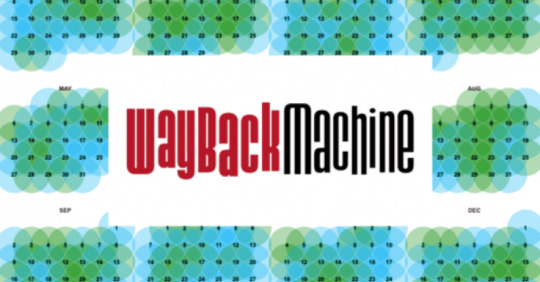
I'm on tour with my new novel The Bezzle! Catch me next in SALT LAKE CITY (Feb 21, Weller Book Works) and SAN DIEGO (Feb 22, Mysterious Galaxy). After that, it's LA, Seattle, Portland, Phoenix and more!

#20yrsago How to get free iTunes from Pepsi with every bottle https://web.archive.org/web/20040319061658/http://www.macmerc.com/news/archives/1270
#20yrsago Woman sued for file-sharing brings RICO countersuit against RIAA https://forums.musicplayer.com/topic/44111-ironic-twist-riaa-sued-by-mom/
#20yrsago FCC Chairman’s astounding statement of Internet Rights https://web.archive.org/web/20041022115925/hraunfoss.fcc.gov/edocs_public/attachmatch/DOC-243556A1.pdf
#20yrsago Free WiFi influences 40% of Schlotskys’s customers https://web.archive.org/web/20040404003117/http://home.businesswire.com/portal/site/google/index.jsp?ndmViewId=news_view&newsId=20040218005460&newsLang=en
#20yrsago Bnetd brief: a legal doc that sings https://web.archive.org/web/20040716143522/https://www.eff.org/IP/Emulation/Blizzard_v_bnetd/20040217_bnetd_Reply.pdf
#20yrsago Jim Macdonald explains writing https://web.archive.org/web/20040317104013/http://pub43.ezboard.com/fabsolutewritefrm3.showMessageRange?topicID=257.topic&start=1&stop=20
#20yrsago Story of the TiVo remote https://www.nytimes.com/2004/02/19/technology/now-preening-on-the-coffee-table.html
#15yrsago Geeks go to New Zealand Parliament to protest new copyright law https://www.flickr.com/photos/taniwha/sets/72157614045293527/
#15yrsago NYPD’s enforcement of non-existent subway photo-ban costing taxpayers a fortune in lawsuits https://www.nytimes.com/2009/02/18/nyregion/18about.html?_r=1
#10yrsago American overseas volunteerism: what really works https://medium.com/thsppl/the-problem-with-little-white-girls-and-boys-b84d4011d17e
#10yrsago Hungry man defeats TSA’s war on peanut butter by spreading it on crackers https://takingsenseaway.wordpress.com/2014/02/13/letter-from-a-passenger-i-made-a-bagful-of-peanut-butter-crackers-and-was-no-longer-considered-a-terrorist-threat/
#10yrsago American citizen and EFF sue Ethiopian government for installing British spyware on laptop https://www.eff.org/press/releases/american-sues-ethiopian-government-spyware-infection
#10yrsago Dante for fun: kids books that retell the Inferno, Purgatorio and Paradiso https://memex.craphound.com/2014/02/18/dante-for-fun-kids-books-that-retell-the-inferno-purgatorio-and-paradiso/
#10yrsago Tessellated Escher cookies https://www.flickr.com/photos/fdecomite/12598506655/in/pool-41894168726@N01
#5yrsago 童絵解万国噺: a wonderfully bizarre 19th century Japanese fanfic history of America https://twitter.com/nick_kapur/status/1062823813338091520
#5yrsago Public records requests reveal the elaborate shell-company secrecy that Google uses when seeking subsidies for data-centers https://www.washingtonpost.com/business/economy/google-reaped-millions-of-tax-breaks-as-it-secretly-expanded-its-real-estate-footprint-across-the-us/2019/02/15/7912e10e-3136-11e9-813a-0ab2f17e305b_story.html
3 notes
·
View notes
Text







A third-generation Japanese American, Roger Shimomura was born in Seattle, Washington and has resided in Kansas since 1969 where he holds the position of Distinguished Professor Emeritus in Fine Art at the University of Kansas in Lawrence. Shimomura’s work in printmaking, painting, and performance art addresses the contradictions and prejudices that frequently characterize America’s cultural diversity. Blending American Pop Art influences with 18th- and 19th-century Japanese woodcut traditions, Shimomura explores both the humor and tragedy that are part of his Asian-American identity.
American Guardian belongs to a group of images created in response to his family’s detention during World War II, when Shimomura was a young child. Utilizing notes from his grandmother’s diaries along with his own recollections, Shimomura produced a haunting series of paintings and prints that reflect his upbringing in wartime internment camps in Washington State and Idaho, a period that lasted more than three years. In a composition that suggests the serene “pictures of the floating world” of Ukiyo-e prints, Shimomura contrasts the innocence of childhood with the harsh realities of an anxious world. The lithograph’s palette of drab military colors combines with the unmistakable symbols of high-security imprisonment to instill in viewers a vicarious experience of the hardships such families endured.
Today’s world again abounds in anxiety-producing occurrences and harsh realities. News reports bear witness to heart-rending instances of international displacement, discrimination, intolerance, and violent acts of hatred. It is often remarked that man’s history is repetitious. George Bernard Shaw wrote, in Man and Superman, “If history repeats itself, and the unexpected always happens, how incapable must Man be of learning from experience.” As we engage in public debate over issues of immigration, the handling of refugees, and the extent of humanitarian duty, it is easy to lose touch with our common and natural compassion. Shimomura’s print is a graphic reminder to reflect on our own history and shared humanity while we face these unfortunately familiar challenges. Citing Shaw again, from The Devil’s Disciple: “The worst sin towards our fellow creatures is not to hate them, but to be indifferent to them: that’s the essence of inhumanity.”
By Dennis Harper, curator of collections and exhibitions
Jule Collins Smith Museum of Fine Art
7 notes
·
View notes
Text
Top 7 Comfort Films Tag
@grotesque-hallucinations tagged me a while ago to share my comfort films. 💜
Pretty much all my favorite movies are romance, about music & bands, or ones from my childhood…
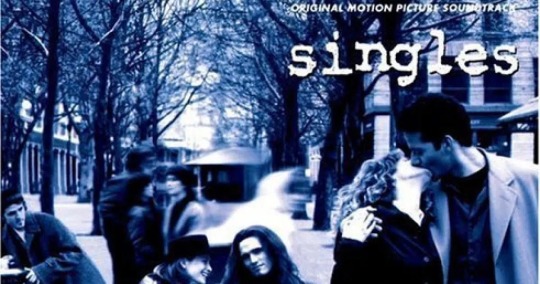
Singles (1992)
This is my favorite movie of all-time for over a decade now. I think it is just such a great depiction of dating & relationships and it has the absolute best soundtrack in the world. The escapism to 90’s grunge Seattle always appeals to me. 💙

History of the Eagles (2013)
A music documentary about one of my favorite bands in the world. Sunny 70’s California escapism, and incredible heartfelt stories and hilarious commentary from the men themselves. Love those guys so much. 💛
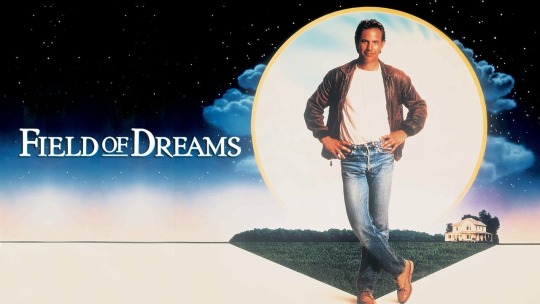
Field of Dreams (1989)
A childhood favorite for me. Just feels like summers as a kid, and good memories.
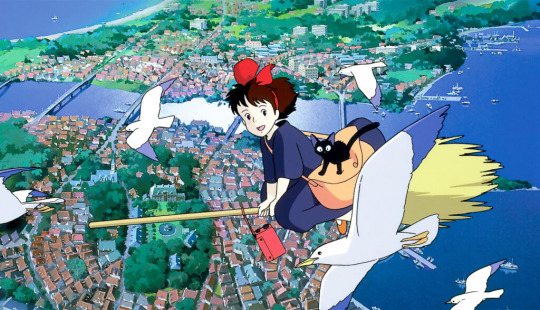
Kiki’s Delivery Service (1989)
Another childhood classic for me. 💜 The first Japanese animation I ever saw, that set me on the path to be the weeb I am today. I always identified a lot with Kiki and wanted to be like her when I grew up.

Almost Famous (2000)
More 70’s escapism. 💛 And my dream life of being a music journalist for Rolling Stone / groupie / following a band around the country.

A Cinderella Story (2004)
Growing up I was OBSESSED with Hilary Duff and this movie especially. It still holds up tbh and gives me that good dose of 2000’s teen movie nostalgia I need to get through life.

St. Elmo’s Fire (1985)
The plot of this movie is kind of a disaster, but I love every minute of it. There’s just something so rewatch-able about it (probably my obsession with the 80’s), plus I’m in love with Andrew McCarthy. 😩❤️ It has all the “coming-of-age” and “lost in our twenty-somethings” tropes that I never get tired of.
There are definitely more honorable mentions but these were the first that came to mind.
This was fun ^^ I’ll tag anyone who sees this and wants to participate!
2 notes
·
View notes
Note
I know this is a super broad question, but; I'm in Chicago this weekend for MPCA/ACA and was wondering if you have any recommendations on what I could do in my freetime? Any smaller/niche museums or bookstores or whatever. Anything you think is interesting/nerdy. And food, of course! Food recommendations are always good :)
Oh man, I wish I had less touristy answers to give you, but I live just enough outside of the city that I mostly do touristy kinds of things when I go down there, and I've only been once since the 2020, so a lot of my answers aren't open anymore/didn't survive the pandemic.
BUT: I do have one that's not touristy! If you're into crafting or found objects at all, there's a secondhand crafts supply store called The WasteShed on Kimball Ave. that's very cool. My favorite thing there are the collections of donated old family photos and slides that people just sort of... give away, when someone in their family dies and they don't want to keep the personal effects(?????). I found an amazing pair of gorgeous family portraits from 1928 in Tokyo last time I was there. The family's names, ages, and the date are all written on the back in both Japanese and English. I'm glad those portraits didn't go into the landfill. But I'm a Small History person who loves things like ephemera. They also have tons of stuff for every type of art or craft imaginable!
Greektown also used to be super cool, but I don't know whether it still is. AFAIK the big tentpoles all didn't survive the pandemic, so don't quote me on that one.
I'm also always going to hype the fairy castle at the Museum of Science & Industry. It was created by and for Colleen Moore, the flapper and silent film star, and she used to tour the country with it to show at children's hospitals. It's fucking amazing. There's a 1" actual Guttenberg bible in there. There's a polar bear rug made of mink and mouse teeth. There's mother-of-pearl chairs made from her earrings from the set of a movie. There used to be running water on the Weeping Willow, but they had to turn off the water in the '90s because it was eating through the materials after 70 years. It's truly my favorite dollhouse, and I've seen the Nutshell Studies.
...I also love American Girl Place but that's literally just a me thing. I also sort of hate-love it, because they have Lost Their Way Severely.
I also am a big fan of the Field Museum -- I know, I know, museums evil, but it does genuinely seem like they're trying to course-correct and make amends -- and the Shedd Aquarium (same). You can touch a manta ray. You can see otters. You can smell penguins. I mean, you can also see them, but boy can you smell them. And Sue (the t-rex at the Field) is an unofficial Chicago mascot.
This is a good list of cool bookstores in the city, which I have to say I haven't explored as much as I should. I've been to a ton of cool bookstores in the Twin Cities, New York, and Staten Island, and some in the SF area and Seattle, but I haven't really explored the ones in Chicago too much because there used to be THE BEST children's/YA bookstore in my suburb and it was where I spent my entire life. This list looks like it has good options for many neighborhoods in the city, though, so wherever you're staying there should be something near-ish to you.
Which is kind of the other reason I haven't explored Chicago as much as other cities in which I've lived, despite living here the longest: public transit here FUCKING SUCKS and I hate city driving more than anything in the world. Maybe you'll have a better experience with the L than I ever do, though, so don't let me being terrible at the L put you off trying it out. I just am not good at it. I can do the subway! I can do trams and the Skyway! I can do street maps okay! I cannot do the L. Somehow every single time I try, I miss a stop and have to circle all the way around again.
Ooh, one other fun thing I did in like 2019 in the city was go ax-throwing, so if you want to try that, they have that right near the symphony building. That's surprisingly fun and not scary.
Food-wise, Chicago is full of good food. Pretty much everything I've ever eaten in the city was great, from the popcorn at Union Station (YOU MUST GET THE CHEDDAR AND CARAMEL MIX AT UNION STATION. IT IS THE BEST POPCORN.) to the $600+ per plate price fixe at Alinea (the only good thing I ever got from an ex). I feel like Sam @copperbadge has a more "a la minute" (hyuk hyuk) set of opinions about Chicago dining than I do -- like I said, a lot of the places that I really liked didn't survive the pandemic or they're outside of the city itself.
Oh! And it is sort of touristy but also very nerdy: the International Museum of Surgical Science. There's an exhibit right now about Frankenstein!
Honestly, looking at the MPCA/ACA website, I'm just jealous you get to be doing/seeing that all weekend. I feel like that's the nerdiest and most fun-seeming ticket in town. What are you there to present or see specifically?? I'm so intrigued!
4 notes
·
View notes
Text

一件 19 世紀的日本消防員外套,上面裝飾著一隻盤旋在廢棄圍棋棋盤上的蜘蛛。 A 19th century Japanese Firemen’s coat decorated with a spider hovering over an abandoned Go board.
-from "Museum Of Artifacts"history blog-
an early-nineteenth-century firefighter’s coat, called hikeshibanten, since it features a spooky spider. Made in the Edo period in Japan, these firefighter’s coats were reversible, and this design is actually on the interior of the jacket, only visible when the jacket has been turned inside out. A large spider—with an endearing face—looms over the shoulder of the jacket, where it hovers menacingly over an abandoned go board (Pacific Northwesterners may have unnerving flashbacks to the giant house spiders that descend on Seattle in the autumn). The range of tonalities centers on indigo, white, black, and greyish-brown, with red accents on the fan; this color palette visually unites the work, creating parallels between the spider’s eyes and the go pieces.
The method of dyeing used, tsutsugaki, is a type of resist dyeing. The design was drawn on the cotton using rice paste, and these initial lines are visible now as the lightest areas of the design. The spider and the go board were dyed their respective colors, and covered with more rice paste to block any other dye from entering the area. Then the fabric was dipped into indigo multiple times, dried, soaked in hot water again, and the rice paste was scraped off to reveal the layering of colors; this whole process could take 20 days.
The scene is from the story of the warrior-hero Minamoto no Yorimitsu (948–1021) who, once when sick, was visited by an evil priest in the guise of a giant spider. Yorimitsu saw through the disguise and attacked the spider priest, and his four attendants (who were playing a game of Go while guarding him) leapt up to track the intruder back to his den.
5 notes
·
View notes
Note
Hello Maple 🍁
As said before, I am here to give you feedback on the reading and my month of May. "Feeling like not quite hitting the goals I set" Oh hell yes! Haha, it was quite a uh scary feeling I think. I am trying to get some work done now though. Still the consistency will take a few days to even start. 🥹
You know what? The UN said we will experience the hottest recorded summer in history between the years 2023-2028 AHAAAA that's terrible. Summers burn you up. Not saying harsh winters are good, the elders experience more pain because of lowwww temperatures but still... An optimal temperature is the best, that is neither too cold nor too hot.
Is it today? The concert you were going to with your friend? If it is, ENJOYYYYYYY tell me later how it was!!!
Am I watching anything lately? You bet, it is vacation, and I am not at the place to do lots of work sooo YESSSS. Like, recently, I watched a movie called "The Intern", it was such a feel good movie. All good and sweet vibes. Such a nice movie. I can go on and on. Nothing intense or whatsoever, 1-2 scenes maybe like that but there is that nothing much. And yesterday, I watched the entire "Tangled" at once. I have watched it on TV before but never at once all, I loved it! Hihi I watched the series "Sweet Home" and am waiting for Season 2 now. There are 2-3 more I have. Right now, I am watching "The Kiss that kills" I started it solely because my favourite Japanese actor was in the lead but I am staying for the plot and it's fun! Another, this drama is going on, "The Good Bad Mother" the acting is >>> Plus lots of things!
Psychology in Seattle sounds wonderful, I actually searched it on Spotify! There is a lot to hear and gather there!
Also, this thing I want to tell you, you know I really really love how I write this ask to you once or twice a month, telling how everything is going and stuff! It's like a letter. Not physical but at least digital. It's exciting for me!
Also, how have you been feeling lately? Are you taking care? The heat is rising here, maybe there too! Remember to stay hydrated 🥰 🥤🥤🥤
I thought to ask for the June reading here but nvm I will send a separate ask for it! This letter is long enough as it is. 😅
Love you, thank you 🤞🏻🩷🍀
Hi friend!
Just remember it's okay to not hit your goals! You don't always need to hit all your goals, you are allowed to take rests and breaks!
Ugh, I believe that!! It was a warm winter here, which I don't mind as it means more snow. But already it's been quite hot here this summer too, which is not nearly as nice.
I can't remember when you sent this, but the concert was the 26th of May! It was so much fun, I'm so glad I went!
I think I've heard of The Intern!!! Those all sound like interesting shows too!
I love to hear it!! It's like a little diary haha, it's the best <33
I've been well! Maybe a little sad, but nothing I can't survive. It is getting hot here too, like I said earlier. I hate the heat haha, it's a big reason why I'm happy to move out west, where it stays colder for a lot longer!
Lots of love my friend <3
2 notes
·
View notes
Text
GTAW: Chapter 18 Notes
1. If you’re a baseball lover like myself, and want to learn more about Japan’s passion for the sport, and the differences between the American and Japanese philosophies, I’d recommend “You Gotta Have Wa: When Two Cultures Collide on the Baseball Diamond” by Robert Whiting. The two quotes above I got from this book.
But if you don’t want to do that, you can watch this 10 minute video instead.😜
A ⚾️ — Also, there’s no easy way to say this, but the only way to understand baseball is to watch a game. Multiple games, at that. You can watch complete games on YouTube or the MLB website. You can also watch instructional YouTube videos, but I can almost guarantee you’ll be left confused. There are a lot of unwritten rules in baseball and it can be difficult for a beginner to fully grasp them right off the bat (see what I did there?😉). However, I found some videos that might help as you learn.
Brief history of baseball in America (funny/dark humor)
I would also be remissed if I didn’t mention anything about The Negro League. Very important stuff, especially when explaining how baseball first came to Japan.
⭐️The different kinds of pitches.
The history of the baseball cap.
⭐️The official rules of baseball.
B ⚾️ — Major League Baseball (MLB) is the #1 pro baseball organization in the United States (and Canada). It comprises 30 teams and is divided into two leagues: the Nation League (NL), and the American League (AL).
The regular MLB season consists of 162 games a year.
The annual championship of the MLB is known as the World Series. Why it is called the World Series when it’s only held in the United States (and Canada)? Good question. I have absolutely no clue. Chalk it up to American arrogance, I guess.
The MLB is responsible for maintaining and interpreting the official rules of baseball. All international leagues, including those in Korea, Japan, Taiwan, the Dominican Republic, Cuba, Venezuela, you name it, more or less adhere to the official rules of baseball as codified by the MLB. Think of baseball as a regulated good, like champagne or Swiss chocolate.
And to put money in perspective, The New York Yankees are the most valuable MLB team, worth an estimated $7.1 billion alone, which doesn’t even count the other 29 teams, many of whom also range in the billions and multi-millions.
C ⚾️ — The Nippon Professional Baseball (NPB) is the #1 professional baseball organization in Japan. Locally it is called the Puro Yakyū. It comprises 12 teams and like the MLB is also divided into two leagues: The Central League (CL), and the Pacific League (PL).
The regular NPB season consists of 130 games a year.
The annual championship of the NPB is called the Japan Series, which makes sense, unlike the MLB.
The two most successful teams in NPB history are the Yomiuri Giants and the Hanshin Tigers.
D ⚾️ — The World Baseball Classic is the FIFA World Cup of baseball, though not as many countries participate. It’s only been around since 2006 and sometimes crazy drama happens and it’s awesome. Most baseball lovers (and I’m thinking specifically of snobbish Americans) consider the World Series to be the ultimate championship, not the WBC, but try telling that to the Japanese.😂
Fun fact. Team Japan were the first WBC champions in 2006 and they are this year's 2023 champions as well. Pretty neat. I watched the game. It was electric. Congratulations Japan!!!🥳🎉🎊👏🏻👏🏻👏🏻
E ⚾️ — In the past it was heavily frowned upon for a Japanese player to sign with an MLB team, mainly for two reasons: One, Japanese natives didn’t like their top athletes playing away overseas. And two, it was seen as a selfish money grab. (MLB players get paid A LOT more than their international counterparts.) Although, nowadays when a Japanese player makes it to “the Bigs” it’s seen as an act of national pride, which is why Satoru has a Seattle Mariners “away” jersey (Ichiro Suzuki) and a St. Louis Cardinals “home” jersey (So Taguchi). 🇯🇵
F ⚾️ Satoru says he doesn’t have a favorite player, but when Shohei Ohtani steps onto the scene that all changes. He develops a HUGE man-crush on the guy and won’t shut up about him:
SATORU: The man is a beast, Hannah. A Beast!!!😤
HANNAH: Yes, dear, we know. You’ve said it a million times already.😒
2. Here, Satoru quotes from the Inquiry of Urga. While not a major religious text, I’d like to think Satoru is well versed in many texts. It’s also worth noting that most Japanese are not religious, but I think religion makes the plot more interesting.
3. Okashi Gaku’s “Cake in a Can.”
Overview of some Japanese vending machines. I would love having a security goat. 🐐 I pass on the bugs though.🐜🐜🐜
4. Koishikawa Kōraku-en (Garden for Taking Pleasure Later) really is located right next to the Tokyo Dome as is an amusement park.
The “Big O” Ferris wheel.
Going up inside Tokyo Tower.
The Skytree is actually twice as tall as Tokyo Tower, but I think Tokyo Tower is prettier and more romantic since it’s modeled after the Eiffel Tower, so that was my rationale.
I have no idea whether Hannah would be able to see all of Tokyo from that height, but let’s pretend. Tokyo is massive.
5. This is also a good thing to point out, but my beta reader asked me why I didn’t mention anything about sumo wrestling, since it is technically Japan’s official national sport. Long story short, sumo has been embroiled in a lot of scandals recently and is not as popular with younger audiences. That being said, sumo will never disappear from Japan and holds great cultural significance, but viewership wise, baseball is more popular than sumo. However, you can watch this short video and decide for yourself.
Here is also a brief history of sumo.
2 notes
·
View notes
Text
I saw a sushi post a while ago where all the California Roll, Alaska Roll, Seattle Roll, etc were being mocked as appropriation and Americans making everything about themselves.
I went to look up the history of those, and every single one of them was a Japanese cook working with local ingredients to make something that celebrated their home and their culture.
I do think it’s unfortunate that people (europeans) automatically assume that “american” style versions of foods are immediately the most bastardized version done purposefully out of lack of culture, when the reality a lot of times it’s rooted in a response of millions of poor immigrants stepping foot in a foreign land attempting to recreate beloved recipes with what few ingredients were available and affordable
8K notes
·
View notes
Text
Secret Spots in Seattle
Seattle’s more than just Pike Place and the Space Needle. This city has many lesser-known spots that feel like they’re just waiting to be discovered. If you want to explore beyond the usual tourist stops, here are a few hidden gems you should check out.
1. The Fremont Troll 🗿
his isn’t your average piece of art; it’s a massive, quirky sculpture lurking under the Aurora Bridge. Created in 1990, the troll holds a real Volkswagen Beetle in its hand and has become a popular spot for photos. It's funky, a little weird, and definitely worth a visit. Plus, Fremont itself has a laid-back vibe with local shops and cafés nearby if you want to explore the neighborhood more.
2. Kubota Garden 🌸
Looking for some peace and greenery? Kubota Garden is a beautifully landscaped Japanese garden tucked away in Rainier Beach. It's free to enter, and you’ll find it’s a perfect place to escape the city noise. The garden was created by Fujitaro Kubota in the 1920s, blending Japanese design with the Pacific Northwest’s natural beauty. You’ll find ponds, stone paths, and tons of vibrant plants and trees that change with the seasons.
3. The Museum of Pop Culture 🎸
MoPOP might not be entirely “hidden,” but it’s often overlooked by visitors who stick to the more traditional museums. Dedicated to everything pop culture, from music to sci-fi, it’s a place where you’ll find exhibits on Jimi Hendrix, horror films, video games, and more. The building itself is hard to miss, with its colorful and modern design, but inside is where it really comes alive. Each exhibit is interactive, making it a great stop for any music, movie, or gaming fan.
4. The Ballard Locks & Fish Ladder 🐟
The Ballard Locks (officially called the Hiram M. Chittenden Locks) is one of Seattle’s best-kept secrets, especially if you’re into engineering or nature. Built to let boats pass between the saltwater of Puget Sound and the freshwater of Lake Union, the locks also have an underwater fish ladder where you can watch salmon swim upstream during spawning season. There’s also a beautiful botanical garden nearby, so it’s a great spot to spend an afternoon exploring the nature and history of the area.
5. Chihuly Garden and Glass 🌈
The Chihuly Garden and Glass exhibit, right next to the Space Needle, is an explosion of color and creativity that doesn’t always get the attention it deserves. Dale Chihuly, a Tacoma-born artist, is known worldwide for his mind-blowing glass sculptures, and this place showcases some of his best work. Inside, you’ll find rooms filled with vibrant, intricate glass art that seems otherworldly. The outdoor garden is a highlight—massive glass pieces blend with flowers and plants to create an enchanting landscape that looks different depending on the time of day. If you’re into art or just want some cool photos, this spot is a must-see in Seattle.
(Blog #5)


1 note
·
View note
Text
Los Angeles Dodgers superstar Shohei Ohtani etched his name in Major League Baseball history, becoming the inaugural member of the 50-50 club on Thursday against the Miami Marlins.
A 50-50 season consists of 50+ home runs and 50+ stolen bases in a single season.

Ohtani, who became the fastest player to record 40 home runs and 40 stolen bases in a single season, hit his 50th homer of the season in the top of the seventh inning after stealing his 50th and 51st base earlier in the game.
The Japanese two-way sensation is 5-for-5 with seven RBIs in the game, giving the Dodgers a 14-3 lead with his historic home run.
The closest anyone has come to the 50-50 mark was Atlanta Braves' Ronald Acuña Jr., who stole 73 bases and hit 41 home runs in 2023, and Alex Rodriguez, who as a member of the Seattle Mariners hit 42 home runs and stole 46 bases in 1998.
Read more at the link in our bio.
📸: Megan Briggs/Getty Images
0 notes
Text
Events 8.10 (affter 1950)
1953 – First Indochina War: The French Union withdraws its forces from Operation Camargue against the Viet Minh in central Vietnam. 1954 – At Massena, New York, the groundbreaking ceremony for the Saint Lawrence Seaway is held. 1961 – Vietnam War: The U.S. Army begins Operation Ranch Hand, spraying an estimated 20 million US gallons (76,000 m3) of defoliants and herbicides over rural areas of South Vietnam in an attempt to deprive the Viet Cong of food and vegetation cover. 1966 – The Heron Road Bridge collapses while being built, killing nine workers in the deadliest construction accident in both Ottawa and Ontario. 1969 – A day after murdering Sharon Tate and four others, members of Charles Manson's cult kill Leno and Rosemary LaBianca. 1971 – The Society for American Baseball Research is founded in Cooperstown, New York. 1977 – In Yonkers, New York, 24-year-old postal employee David Berkowitz ("Son of Sam") is arrested for a series of killings in the New York City area over the period of one year. 1978 – Three members of the Ulrich family are killed in an accident. This leads to the Ford Pinto litigation. 1981 – Murder of Adam Walsh: The head of John Walsh's son is found. This inspires the creation of the television series America's Most Wanted and the National Center for Missing & Exploited Children. 1988 – Japanese American internment: U.S. President Ronald Reagan signs the Civil Liberties Act of 1988, providing $20,000 payments to Japanese Americans who were either interned in or relocated by the United States during World War II. 1990 – The Magellan space probe reaches Venus. 1993 – Two earthquakes affect New Zealand. A 7.0 Mw shock (intensity VI (Strong)) in the South Island was followed nine hours later by a 6.4 Mw event (intensity VII (Very strong)) in the North Island. 1995 – Oklahoma City bombing: Timothy McVeigh and Terry Nichols are indicted for the bombing. Michael Fortier pleads guilty in a plea-bargain for his testimony. 1997 – Sixteen people are killed when Formosa Airlines Flight 7601 crashes near Beigan Airport in the Matsu Islands of Taiwan. 1998 – HRH Prince Al-Muhtadee Billah is proclaimed the crown prince of Brunei with a Royal Proclamation. 1999 – Los Angeles Jewish Community Center shooting. 2001 – The 2001 Angola train attack occurred, causing 252 deaths. 2001 – Space Shuttle program: The Space Shuttle Discovery is launched on STS-105 to the International Space Station, carrying the astronauts of Expedition 3 to replace the crew of Expedition 2. 2003 – The Okinawa Urban Monorail is opened in Naha, Okinawa. 2009 – Twenty people are killed in Handlová, Trenčín Region, in the deadliest mining disaster in Slovakia's history. 2012 – The Marikana massacre begins near Rustenburg, South Africa, resulting in the deaths of 47 people. 2014 – Forty people are killed when Sepahan Airlines Flight 5915 crashes at Tehran's Mehrabad International Airport. 2018 – Horizon Air employee Richard Russell hijacks and performs an unauthorized takeoff on a Horizon Air Bombardier Dash 8 Q400 plane at Seattle–Tacoma International Airport in Washington, flying it for more than an hour before crashing the plane and killing himself on Ketron Island in Puget Sound. 2018 – An anti-government rally turns into a riot when members of the Romanian Gendarmerie attack the 100,000 people protesting in front of the Victoria Palace, leading to 452 recorded injuries. The authorities alleged that the crowd was infiltrated by hooligans who began attacking law enforcement agents. 2019 – Thirty-two are killed and one million are evacuated as Typhoon Lekima makes landfall in Zhejiang, China. Earlier it had caused flooding in the Philippines. 2019 – Philip Manshaus shoots his stepsister and attacks a mosque in the Bærum mosque shooting. 2020 – Derecho in Iowa becomes the most costly thunderstorm disaster in U.S. history.
0 notes